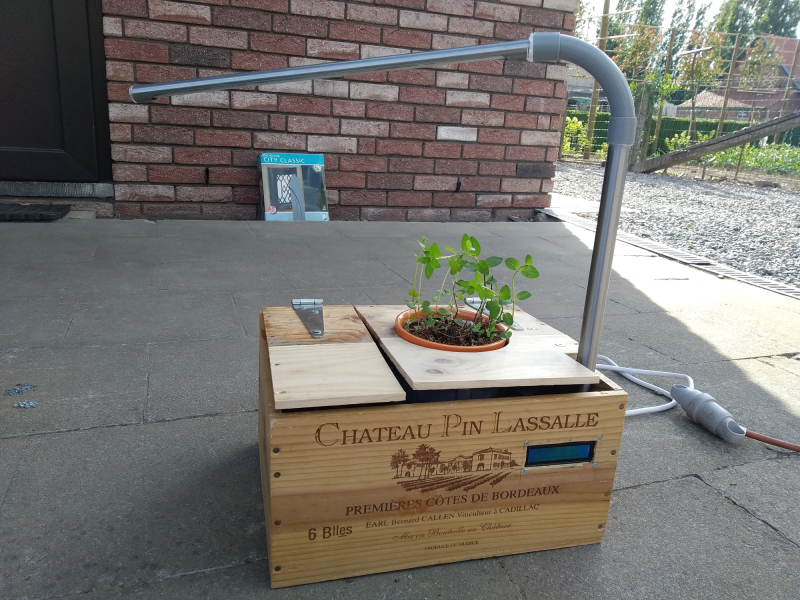Having a few plants around is a great way to liven up your living and/or working space. They look nice, you get to watch them grow and change, and some types of plants can actively improve the room’s air quality. But let’s face it — even the easy ones require a baseline level of care that can easily fall by the wayside. After all, the poor things can’t scream out for water or get up and find a sunnier spot for themselves.
 [Ine Hocedez] was tired of watching her plants die and not knowing why. The two main culprits involve water and light, though there can be other issues like soil pH and bugs. It’s easy to get the balance wrong, so why not automate everything?
[Ine Hocedez] was tired of watching her plants die and not knowing why. The two main culprits involve water and light, though there can be other issues like soil pH and bugs. It’s easy to get the balance wrong, so why not automate everything?
Plant’m is a complete, portable package that [Ine] designed for a school project. A soil moisture sensor dictates the watering schedule via Raspberry Pi, and water is automatically pumped from an elevated tank.
The lamp is meant to supplement the sunlight, not replace it. But that’s the real beauty of this botanical box — [Ine] can just pick it up and try a different spot if the plant droops or shows burnt spots.
Got the sunlight part down for your plant, but can’t remember to water it? Re-purpose an old Keurig and give it an automatic drip.















Awesome – agricultural projects are always great to see.
One issue with Pis is that the cost can grow to be expensive once you get a green thumb and decide to keep more than one plant alive at a time.
They also don’t shine if you want to expand your project into a garden or field. They’re power-hungry, and even if you get a really long power cord or a really big battery, WiFi doesn’t get the best range. Microcontrollers and LoRa go together like peanut butter and jelly for remote monitoring.
But they say that premature optimization is the root of all evil. And it’s super impressive for a student project, this sort of thing looks great on a resume.
…but it’s usually good to just get _any_ prototype to get you going over the hump of procrastination. It helps if it makes development easier.
Software projects tend not to be optimized in their life cycles. They get more and more bloated as time goes on and few developers get to redesign.
Why do so many people buy this garbage soil moisture sensor ? The electrodes will rot awày in no time.
I have yet to find long-term stable and reliable soil moisture sensors (and I’ve dealt with the pack-of-10 NE555 ones and others). Any recommendations?
The key is to use graphite rods (from pencil) to stick into the ground instead of copper wires which corrode. And only running voltage through it when measuring, not all the time – otherwise you are in fact constantly running electrolysis which corrodes the electrodes even faster.
Yes graphite rods. They are also in most traditional (D, C, AA, AAA) batteries when you pull them apart.
Andreas Spiess has a video on moisture sensors. Maybe something useful is in there for you: https://www.youtube.com/watch?v=udmJyncDvw0
Just drop resistive soil moisture sensors alltogether. They SUCK in the long run, even when you take stainless steel or graphite instead of the meager copper on the pcb. Guess what happens when you throw hot weather or especially fertilizer at it.
The only way I know of to get the reading in a partly professional manner is by measuring with a capacitive sensor. This one is really awesome https://www.tindie.com/products/miceuz/i2c-soil-moisture-sensor/ .
There are also brand options for that in professional setups but only the sensor costs more than 100 bucks a piece.
When you want to automate fertilizer administration, you should go for hydroponics. It is the only way to at least somewhat have those cheap glas PH meters and don’t clog the meter in a breeze.
Plants can adapt to the amount of water as long as you don’t go to either extremes.
It is important to not over crowd the container like OP as they will compete with each other. They’ll grow a lot more if you only have one plant per container.
The perfect plant for a workspace is cyperus alternifolius. It requires nothing more than water (maybe a stick or two of fertilizer once a few months). What is really convenient, you can’t overwater and it grows well even in an office without much sunlight.
I’m partial to pothos (Epipremnum aureum) myself. All I do is wash the dirt off the roots, stick them into the top of my aquarium with the roots in the water, and forget all about them. My fish like hanging out in the roots, the pothos seems to like the nitrogen waste my fish produce, and I like both the fish and the plants. It’s a win win.
I’ve been growing some spaghetti squash from seeds I saved last year. My watering solution was to put the seedling pots into a tray which I refilled with water when it went dry (letting it go dry to kill the mosquito larvae of course). Then after planting, I set up a drip irrigation hose. It hasn’t hurt that it rained a couple of times in the two weeks since then. “Look, ma, no Arduino!”